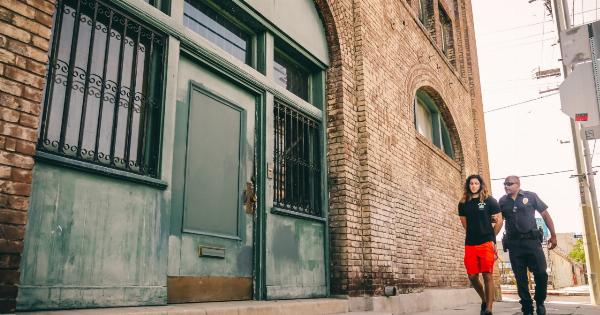Walking and running are two common forms of exercise that allow individuals to stay fit and maintain a healthy lifestyle. Both activities offer numerous physical and mental health benefits.
However, have you ever stopped to consider whether your choice between walking and running could increase your chances of getting arrested? In this article, we will delve into the potential risk factors associated with walking and running, and the legal implications involved in various situations.
1. Public Intoxication
One of the key factors that may lead to potential arrest is the influence of alcohol or drugs.
While it is possible to engage in both walking and running under the influence, the likelihood of getting arrested for public intoxication is higher when walking. As an individual’s mobility is impeded while running, law enforcement officers may find it more difficult to identify signs of impairment.
Conversely, walking is a slower-paced activity, and the signs of intoxication may be more noticeable to authorities.
2. Trespassing
Another situation where walking and running can potentially lead to arrest is trespassing.
While both activities may involve entering private property without permission, running is generally less likely to attract attention from property owners or law enforcement. Most individuals engaging in running are focused on their workout and are more likely to choose public, open spaces. Walking, on the other hand, may involve leisurely strolls that could lead to unintentional trespassing on private property.
Consequently, individuals who choose to walk may find themselves at a higher risk of facing legal consequences.
3. Disturbing the Peace
In certain situations, both walking and running can result in disturbances to public peace. However, running is less likely to be associated with disturbances, as athletes tend to keep to themselves and concentrate on their exercise routine.
Walking, particularly in groups, can sometimes lead to elevated noise levels and disruptive behavior. While it is crucial to note that disturbance of the peace is subjective and highly depended on specific circumstances, walking in large groups may potentially increase the chances of getting arrested for disorderly conduct.
4. Aggressive Behavior
When it comes to aggressive behavior, both walking and running have the potential to contribute to altercations. Running, often considered a solitary activity, may lead to fewer confrontations as runners are usually more focused on their workout.
On the other hand, walking can sometimes involve individuals engaging in arguments or displaying aggressive behavior towards others due to factors such as pedestrian congestion or slower movement. Incidents like these can escalate quickly, leading to confrontations and potential arrests.
5. Public Nudity
While it may seem uncommon, public nudity is a factor that can result in arrests. Although rare, some individuals may choose to run or walk without appropriate clothing in certain situations.
In such cases, both walkers and runners are subject to arrest, as public nudity is against the law in most jurisdictions. It is crucial to respect local laws and regulations, and to understand that engaging in either activity while publicly nude can lead to legal trouble.
6. Loitering
Loitering refers to lingering in a public area without a clear purpose or proper authorization. Both walking and running can be perceived as loitering depending on the circumstances.
However, walking is more commonly associated with this behavior, as people tend to walk at a slower pace and may appear more stationary compared to runners. Individuals who engage in walking activities should be mindful of their surroundings to avoid being mistaken for loiterers and potentially facing legal consequences.
7. Evading Law Enforcement
Evading law enforcement is a serious offense that can lead to arrest.
While walkers can evade law enforcement officers, those engaged in running are generally at a higher risk of being apprehended due to their increased visibility and slower movement compared to vehicles or bicycles. Furthermore, the athletic nature of running allows individuals to cover larger distances, making it challenging to escape detention.
So, while runners may encounter law enforcement more frequently, their likelihood of successfully evading arrest is generally lower compared to walkers.
8. Medical Emergencies
In certain circumstances, both walking and running can lead to medical emergencies. Regardless of the activity, individuals experiencing health issues or injuries may require immediate attention.
In such cases, reaching out for help as quickly as possible is crucial. However, it is important to have an understanding of local regulations regarding medical emergencies.
Good Samaritan laws often protect those who act in good faith to provide assistance in medical emergencies, regardless of the activity they were engaged in at the time.
9. Suspicious Activity
Suspicious activity can lead to heightened law enforcement attention and, in some cases, potential arrest. While both walking and running can raise suspicions under certain circumstances, running may attract additional attention due to its faster pace.
Individuals running with backpacks or other items that may be perceived as suspicious may face increased scrutiny. Walkers, on the other hand, are less likely to be questioned or arrested for similar behavior, as walking typically indicates a less hurried or suspicious intent.
10. Jaywalking
Jaywalking, the act of crossing the street illegally or in an unsafe manner, can result in potential arrest, particularly in traffic-dense city areas.
While walking and running can both involve jaywalking, walkers may be more at risk due to their slower pace and increased potential for distractions. Runners, on the other hand, tend to move faster and are often more focused on their exercise routine, making them more likely to carefully choose appropriate crossing points.
It is important to note that the likelihood of getting arrested while walking or running ultimately depends on various factors, such as local laws, individual behavior, and law enforcement priorities.
The examples mentioned above aim to provide an overview of potential risk factors rather than definitive outcomes. Engaging in either activity responsibly and being aware of local regulations will significantly reduce the chances of encountering legal troubles.






























